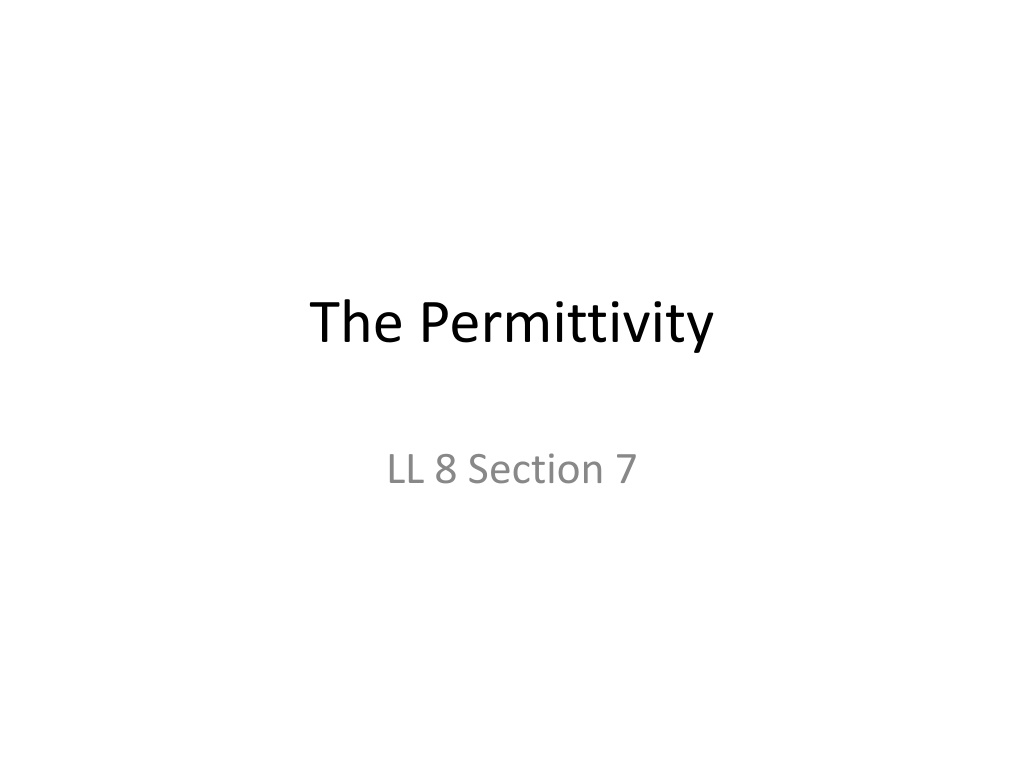
Understanding Dielectric Properties in Materials
Learn about the relationship between induction and electric field, dielectric susceptibility, boundary conditions in linear isotropic dielectrics, and more in materials science and physics. Explore how Maxwell's equations are solved, the concept of polarization, and the role of permittivity in different substances and states.
Download Presentation

Please find below an Image/Link to download the presentation.
The content on the website is provided AS IS for your information and personal use only. It may not be sold, licensed, or shared on other websites without obtaining consent from the author. If you encounter any issues during the download, it is possible that the publisher has removed the file from their server.
You are allowed to download the files provided on this website for personal or commercial use, subject to the condition that they are used lawfully. All files are the property of their respective owners.
The content on the website is provided AS IS for your information and personal use only. It may not be sold, licensed, or shared on other websites without obtaining consent from the author.
E N D
Presentation Transcript
The Permittivity LL 8 Section 7
1. To solve Maxwells equations for a dielectric, we need a relation between induction D and field E. Four equations for 6 unknowns Can t be solved Polarization is due to external field The field E that appears in the medium is usually small compared to the internal molecular fields: Expand the induction in powers of this field. In most cases, we need keep only the first term. The relation we seek is usually linear.
2. Linear Isotropic Dielectric. The most important case. D and E must be in the same direction D||E D= E = permittivity Depends on substance Depends on thermodynamic state
3. Dielectric susceptibility This is not the field that causes the polarization. This is the field that exists after the polarization is established. Polarization is also proportional to the field Polarization coefficient or Dielectric susceptibility > 1 > 0 For static fields For a rarified medium (gas), is proportional to density
4. Boundary conditions at surface between two linear isotropic dielectrics For linear isotropic dielectric For any dielectric The normal component of the field is discontinuous
5. Homogeneous linear isotropic dielectrics Spatially uniform neutral dielectrics have no volume charge density Homogenous dielectrics have spatially uniform permittivity
Volume charge density can occur for inhomogeneous linear isotropic dielectric 0 for neutral dielectric
What equation is satisfied by the potential in a neutral dielectric? If dielectric is homogeneous, then Laplace s equation holds For inhomogeneous dielectric, Laplace s equation doesn t hold.
Boundary conditions on the potential for linear isotropic dielectric = Potential is continuous. (They could differ by a constant, but they wouldn t they would also be different at infinity.) Slope of in normal direction is discontinuous
6. Piecewise homogeneous dielectric (e.g. multilayer optical films) in each homogeneous region. Permittivity appears only in the boundary conditions Boundary conditions involve only the ratios Same solution as
7. Conductor surrounded by homogeneous isotropic linear dielectric 0 everywhere Constant on the conductor surface
vacuum If eD = eV, then D = V / . If D = V, then eD = eV
For a given charge on the conductor (eV = eD) and E are reduced by the factor compared to their values in vacuum. The charge on the conductor is screened by the surface polarization charge on the dielectric. Charged conductor surrounded by dielectric Charged conductor in vacuum
If the potential of the conductor is maintained as it is placed inside dielectric V = D eD = eV Field is unchanged but the charge is increased by the factor . The extra charge is put there by the battery.
8. An uncharged conductor behaves like a dielectric with infinite permittivity Normal component of electric induction is continuous But Requires
Conventions for linear dielectrics Landau & Gaussian Units Permittivity or dielectric constant (unitless) D = E Polarization coefficient or Susceptibility (unitless) Other books & S.I. units Permittivity (not unitless) Relative permittivity or Dielectric constant (unitless) Susceptibility (unitless)
